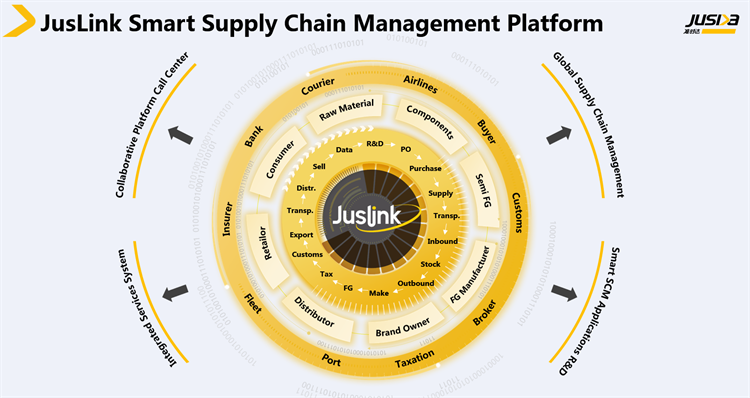JusLink vs Traditional Supply Chain Solutions

Supply chain management plays a crucial role in the success of businesses. Efficient supply chains reduce costs by 15% and improve cash-to-cash cycles threefold. Traditional supply chain solutions have evolved significantly. Modern solutions now dominate the landscape. JusLink, an intelligent supply chain platform, exemplifies this transformation. JusLink enables real-time collaboration and visualization across the entire supply chain network. This digital-driven approach ensures optimal performance and adaptability to market changes.
Understanding Supply Chain Management
Traditional Supply Chain Solutions
Definition and Overview
Traditional supply chain solutions focus on the production and distribution of goods. These systems rely heavily on manual processes and paper-based documentation. Traditional methods often lack real-time visibility and depend on historical data for decision-making.
Key Components
Traditional supply chains consist of several key components:
Procurement: Sourcing raw materials and components.
Manufacturing: Producing finished goods from raw materials.
Warehousing: Storing products before distribution.
Transportation: Moving goods from one location to another.
Distribution: Delivering products to end customers.
Common Practices
Common practices in traditional supply chains include:
Batch Processing: Producing goods in large quantities to minimize costs.
Inventory Management: Maintaining stock levels to meet demand.
Forecasting: Predicting future demand based on historical data.
Supplier Relationships: Managing long-term contracts with suppliers.
Modern Supply Chain Solutions
Definition and Overview
Modern supply chain solutions leverage advanced technology and real-time data. These systems integrate digital tools to enhance efficiency and responsiveness. Modern approaches prioritize customer needs and market dynamics.
Key Components
Modern supply chains incorporate several advanced components:
Data Analytics: Utilizing big data for informed decision-making.
Automation: Implementing robotics and AI for streamlined operations.
Real-Time Tracking: Monitoring goods throughout the supply chain.
Collaboration Platforms: Facilitating communication between partners.
Sustainability Initiatives: Reducing environmental impact through green practices.
Common Practices
Common practices in modern supply chains include:
Just-In-Time (JIT) Inventory: Minimizing stock levels to reduce costs.
Demand Planning: Using real-time sales metrics to forecast demand.
Supplier Collaboration: Engaging in partnerships for mutual benefit.
Technology Integration: Incorporating IoT and blockchain for transparency.
Customer-Centric Approach: Focusing on delivering value to end-users.
Modern supply chains offer greater flexibility and adaptability compared to traditional methods. Businesses can respond quickly to market changes and customer demands. Advanced technology enables real-time insights and efficient resource utilization.
Intelligent Supply Chain: JusLink

Overview of JusLink
JusLink represents a leap in supply chain management. The platform integrates digital-driven smart manufacturing collaboration. This integration links the entire supply chain network. JusLink supports upstream and downstream partners, enabling seamless business collaboration.
Key Features
JusLink offers several key features:
Real-Time Collaboration: Partners can coordinate activities instantly.
Visualization Tools: Transportation, inventory, and materials are visualized for better tracking.
Multi-Role Coordination: Procurement, transportation, warehousing, and customs operations are streamlined.
4PL Solutions: Full-process business outsourcing is available for comprehensive support.
Data Analytics: Advanced analytics provide actionable insights for decision-making.
Benefits
Businesses using JusLink experience numerous benefits:
Efficiency: Streamlined processes reduce operational delays.
Cost Savings: Optimized resource utilization lowers expenses.
Accuracy: Real-time data ensures precise decision-making.
Scalability: The platform adapts to growing business needs.
Sustainability: Green practices minimize environmental impact.
How JusLink Works
JusLink transforms traditional supply chains into intelligent supply chains. The platform leverages IoT, cloud computing, and big data analytics. These technologies enable seamless connectivity and information sharing.
Integration with Existing Systems
JusLink integrates effortlessly with existing systems. The platform supports various enterprise resource planning (ERP) systems. This compatibility ensures smooth transitions and minimal disruptions. Businesses can maintain their current operations while upgrading to JusLink.
User Experience
Users find JusLink intuitive and user-friendly. The platform provides a panoramic view of the entire supply chain. Real-time alerts notify users of potential issues. This proactive approach reduces exceptions and corresponding costs. Users benefit from accurate analysis and efficient resource utilization.
Comparative Analysis
Efficiency and Speed
Traditional vs JusLink
Traditional supply chain solutions often suffer from inefficiencies. Manual processes and paper-based documentation slow down operations. Decision-making relies heavily on historical data, which can be outdated. These factors result in delays and increased lead times.
JusLink Smart Supply Chain platform revolutionizes efficiency and speed. The platform leverages IoT, cloud computing, and big data analytics. Real-time data provides instant insights, enabling quick decision-making. Automation reduces manual tasks, speeding up the entire process. JusLink ensures seamless connectivity and information sharing across the supply chain. This intelligent supply chain approach minimizes delays and enhances responsiveness.
Cost-Effectiveness
Traditional vs JusLink
Traditional supply chains often incur high costs. Manual processes require significant labor, increasing operational expenses. Inventory management can be inefficient, leading to excess stock or shortages. Transportation and warehousing costs can also be substantial due to lack of optimization.
JusLink offers a more cost-effective solution. The platform optimizes resource utilization through real-time data and automation. Efficient inventory management reduces excess stock and associated costs. JusLink's visualization tools improve transportation and warehousing efficiency. Businesses benefit from lower operational expenses and better financial performance. The intelligent supply chain approach of JusLink ensures cost savings and improved profitability.
Flexibility and Scalability
Traditional vs JusLink
Traditional supply chains often lack flexibility. Manual processes and rigid structures make it difficult to adapt to market changes. Scaling operations can be challenging and time-consuming. Businesses may struggle to meet fluctuating demand and customer expectations.
JusLink excels in flexibility and scalability. The platform adapts to changing business needs with ease. Real-time collaboration and visualization tools enable quick adjustments. JusLink supports multi-role coordination, facilitating seamless scaling. The intelligent supply chain platform grows with the business, ensuring continuous improvement. Businesses can respond swiftly to market dynamics and customer demands.
Challenges and Solutions

Challenges in Traditional Supply Chain
Common Issues
Traditional supply chains often face several common issues. Manual processes dominate operations, leading to inefficiencies. Paper-based documentation slows down information flow. Lack of real-time visibility hampers decision-making. Historical data reliance results in outdated insights. Coordination between partners becomes challenging due to siloed systems.
Impact on Business
These issues significantly impact business performance. Inefficiencies increase operational costs. Delays in information flow lead to slower response times. Outdated insights result in poor decision-making. Coordination challenges disrupt the supply chain, causing delays and stockouts. Businesses struggle to meet customer demands, affecting satisfaction and loyalty.
How JusLink Addresses These Challenges
Solutions Provided
JusLink addresses these challenges with advanced solutions. The platform integrates cutting-edge technology into supply chain management. Real-time collaboration tools enhance coordination between partners. Visualization tools provide a panoramic view of the supply chain. Automation reduces manual tasks, increasing efficiency.
JusLink leverages IoT, cloud computing, and big data analytics. These technologies enable seamless connectivity and information sharing. Real-time data provides instant insights for quick decision-making. The platform supports multi-role coordination, streamlining operations. Businesses benefit from accurate analysis and efficient resource utilization.
By addressing traditional supply chain challenges, JusLink ensures optimal performance and adaptability. Businesses can respond swiftly to market dynamics and customer demands. The intelligent supply chain approach of JusLink leads to cost savings, improved efficiency, and enhanced customer satisfaction.
Practical Advice for Implementation
Steps to Transition from Traditional to JusLink
Initial Assessment
Businesses must start with a thorough initial assessment. Evaluate current supply chain processes and identify inefficiencies. Determine the specific needs and goals for adopting JusLink. Conduct a gap analysis to understand the differences between existing systems and JusLink's capabilities. This assessment will provide a clear roadmap for the transition.
Planning and Strategy
Develop a detailed planning and strategy phase after the initial assessment. Define the scope of the implementation project. Set realistic timelines and allocate resources effectively. Identify key stakeholders and assign roles and responsibilities. Ensure that all team members understand the objectives and benefits of JusLink. Create a comprehensive plan that includes risk management strategies.
Execution and Monitoring
Begin the execution phase by integrating JusLink with existing systems. Follow the plan meticulously and monitor progress regularly. Use JusLink's real-time data and visualization tools to track the implementation process. Address any issues promptly to avoid delays. Maintain open communication with all stakeholders to ensure smooth execution. Regularly review performance metrics to gauge the success of the transition.
Evaluating the Success of JusLink
Key Performance Indicators
Measure the success of JusLink using key performance indicators (KPIs). Track metrics such as operational efficiency, cost savings, and lead times. Monitor inventory levels and transportation efficiency. Evaluate customer satisfaction and response times. Use these KPIs to assess the impact of JusLink on overall business performance.
Continuous Improvement
Adopt a continuous improvement approach to maximize the benefits of JusLink. Regularly analyze performance data and identify areas for enhancement. Implement changes based on data-driven insights. Encourage feedback from all users to refine processes. Stay updated with the latest advancements in intelligent supply chain technologies. Continuously optimize operations to maintain a competitive edge.

SMART JusLink
Supply Chain Management Solution
Choosing the right supply chain solution is crucial for business success. JusLink offers significant advantages over traditional methods. The platform provides real-time collaboration, visualization tools, and advanced analytics. Businesses can achieve greater efficiency, cost savings, and scalability. JusLink ensures optimal performance and adaptability to market changes. Consider adopting JusLink for an intelligent and efficient supply chain.
See Also
The Superiority of JUSDA's Industry-Leading Supply Chain Solutions
JUSDA's Transformation of Supply Chain Sustainability
Optimizing Performance: JUSDA's Comprehensive Supply Chain Visibility
JUSDA: Leading You to Success in Supply Chain Resilience
Understanding Advanced Manufacturing: JUSDA's Revealed Logistics Solutions
